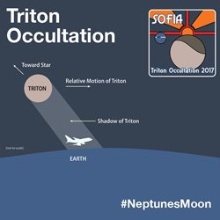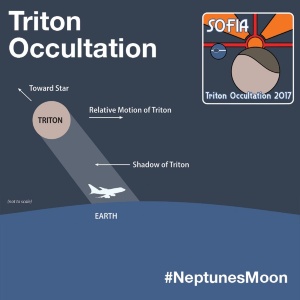During the night of October 5 th, a very rare celestial event took place: Triton, the largest moon of the planet Neptune with a diameter of ~ 2700 km, passed in front of a bright star (UCAC4 410-143659, V = 12.7 mag) – analogous to a solar eclipse. Depending on the location of the observer, this so-called occultation lasted no longer than three minutes. For a brief moment, the light of the star illuminated the atmosphere of the Neptunian moon from behind. That gave astronomers the opportunity to study the thin Triton atmosphere in detail - assuming their telescopes were positioned in the shadow that Triton projected on the Earth during this event.
-
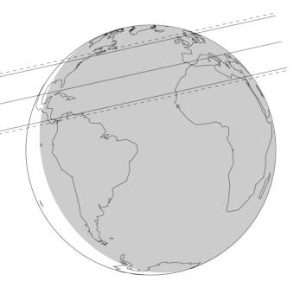
In the morning of 6th October 2017, Triton’s shadow was first
observed in Southeastern Europe around 1:47, then moved
across Central and Western Europe and the Atlantic Ocean,
and reached the US East Coast around 1:54
(Copyright: MIT)..
SOFIA, the flying infrared observatory, flew directly into the center of the shadow to observe the so-called "Central Flash". This momentary brightening can only be observed in a narrow zone around the geometric center of the shadow, when the light of the fully covered star is refracted by Triton’s atmosphere towards the observer. The properties of the atmosphere determine the intensity and shape of the Central Flash. Using three powerful instruments aboard SOFIA, a team led by Ted Dunham (PI) vom Lowell Observatory and Michael Person of the Massachusetts Institute of Technology (MIT) was able to study the lower layers of Triton’s atmosphere in detail, which are largely responsible for this brief brightening. One of the instruments used on board SOFIA, the Focal Plane Imager (FPI+), was developed under the leadership of Jürgen Wolf at the German SOFIA Institute (DSI) of the University of Stuttgart. "We were able to observe the Central Flash with all three instruments," Mike Person confirms. "The preliminary analysis of the light curves reveals interesting features” promises the astronomer. Images in different filter bands of optical and infrared light allow scientists to derive the particle content, temperature, density and pressure in Triton's gas envelope.
-
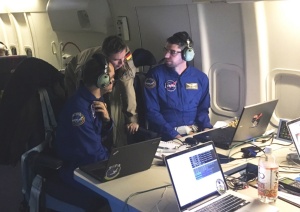
Enrico Pfüller (right) & Manuel Wiedemann (left) on board
SOFIA, in a conversation with Holger Jakob during the
preparation of the occultation observation at the FPI+ console
(Copyright: DSI / USRA).
"SOFIA is the only observatory that can position itself right in the center of an occultation - no matter where the shadow will be on Earth," says Enrico Pfüller from DSI, who operated SOFIA’s tracking camera and science instrument FPI+ during the Triton mission together with his colleague Manuel Wiedemann. "We were at the right place, at the right time, down to the second, successfully monitoring the occultation with the FPI+ and two other instruments." As Triton was casting its shadow too far away from SOFIA's home base at the NASA Armstrong Flight Research Center in Palmdale, California, the flying observatory departed from a temporary base in Daytona Beach, Florida for this particular mission. This allowed SOFIA to reach the center of the shadow without any additional stop over, and to return to Daytona Beach after nine hours of flight.
Ground-based and airborne observations complement each other perfectly
-
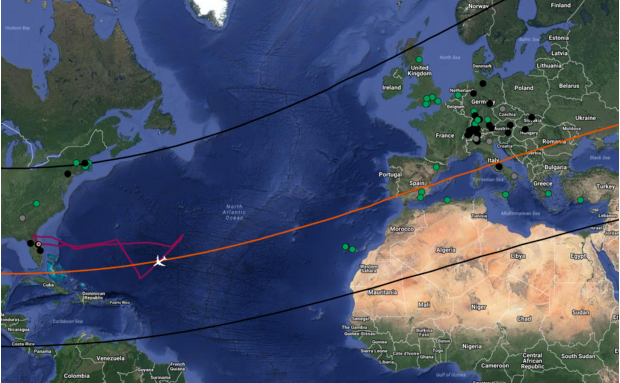
The path of Triton's shadow over the surface of the Earth (ignoring the extent of Triton's atmosphere, which will be determined from the observations) is indicated by black lines on this map, while the orange line marks the track of the shadow center. SOFIA's flight plan is indicated by the red line; the location of the crucial, approximately three-minute long observation is marked by the aircraft symbol. The individual points represent ground-based telescopes that participated in the observation campaign supporting SOFIA’s mission (green - successful observation, black - no observation due to cloud cover, gray - incomplete data due to difficult weather conditions). (Copyright: DSI / Karsten Schindler, Map data: © 2017 Google Imagery © 2017 NASA, TerraMetrics, Flight path: FlightAware).
While Neptune is about 17 times heavier than Earth, its mean distance to Triton is less than the Earth–Moon distance. Triton is thus exposed to much stronger tidal forces than our Moon. This results in a deformation of Triton’s atmosphere, which has been seen in previous measurements. In order to accurately measure the global extent, shape and structure of the atmosphere, the SOFIA team was supported by numerous researchers who observed the event from more than 75 ground-based telescopes all across Europe and the US East Coast in parallel. The European observing campaign that supported SOFIA was organized by Karsten Schindler at DSI, who started coordinating observers already back in October 2016. He observed the occultation at the 2.2 m telescope at Calar Alto Observatory in southern Spain. "Although we were located south of the predicted centerline of the shadow, we were able to observe a clear signature of a “Central Flash”, which came as a great surprise"," Karsten Schindler says. "The AstraLux instrument that we were able to use worked perfectly, and enabled a light curve measurement with very high temporal resolution, providing us valuable additional information about the true nature of Triton’s atmosphere."
-
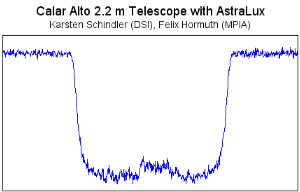
 Left: Preliminary light curve of the Triton occultation, obtained with AstraLux at the 2.2 m
telescope on Calar Alto in southern Spain (Copyright: Karsten Schindler / DSI). Right: Time-lapse
animation of the occultation from images recorded with AstraLux at the Calar Alto 2.2 m telescope
(Copyright: Karsten Schindler / DSI).
Left: Preliminary light curve of the Triton occultation, obtained with AstraLux at the 2.2 m
telescope on Calar Alto in southern Spain (Copyright: Karsten Schindler / DSI). Right: Time-lapse
animation of the occultation from images recorded with AstraLux at the Calar Alto 2.2 m telescope
(Copyright: Karsten Schindler / DSI).
The interim result of the Triton ground based Campaign is promising. A total of 37 stations reported a successful observation: 9 stations in the US, 27 stations in Europe, and 1 station in Africa. Among them are also large telescopes on the Canary Islands, in Italy and Turkey. Hence, Triton’s atmosphere could be measured in different latitudes of the moon.
Pluto's brother or Transneptunian object?
-
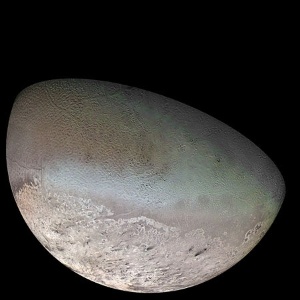
3-color image of Triton, obtained during the Voyager 2
flyby of the Neptune system in 1989
(Copyright: NASA / JPL / USGS).
Neptune’s moon Triton is of similar size and mass as the dwarf planet Pluto. That is why planetary researchers wonder if Triton and Pluto are dwarf planet siblings. Or was Triton originally a so-called trans-Neptunian object (TNO), which has been captured by the outermost gas giant of our solar system? So far, the only close-up images of Triton were obtained by NASA’s space probe Voyager 2 during a fly-by at Neptune and Triton in August 1989. Data have shown that Triton's atmosphere consists mainly of nitrogen, and shows signs of tides and winds. After the fly-by of Voyager 2, Triton's atmosphere could be studied through occultations between 1993 and 2001, for example by SOFIA's predecessor, the Kuiper Airborne Observatory (KAO). It was found that the atmosphere continued to expand. "The ground-based campaign provides information on Triton's upper atmospheric layers, which complements SOFIA's new multispectral data perfectly. Combined together, these observations can provide a more detailed understanding of the different layers of the atmosphere, and will show how much it has changed since the 1990s", summarizes Jürgen Wolf.
Further Links to the Triton Occultation
- Video about the Triton Occultation
- Pressrelease of the SOFIA Science Center
- NASA Press Release: Catching the Shadow of a Neptunian Moon
- Pinpoints of Light: Triton Occultation Prediction by Amanda Bosh MIT Department of Earth, Atmospheric and Planetary Sciences (EAPS)
- MIT Homepage about the Triton Bedeckung
- Neptune's Moon Triton to Occult Star, Sky and Telescope
- View from Mars Hill: Occultation of Triton drew on Flagstaff astronomers
- Neptun-Mond Triton bedeckte Stern – und viele schauten zu, Abenteuer Astronomie
Weitere SOFIA Links
| Contact | Dörte Mehlert, Email: mehlert@dsi.uni.stuttgart.de; Tel.:0711 - 685-69632 |
|---|


